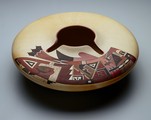
 |
Dextra Quotskuyva |
Seed jars were used to store the seeds collected for the next year's planting, an essential part of the unending cycle of cultivating and harvesting crops. In times of food scarcity, they were also used to store the seeds of wild plants, which were ground up and mixed with cornmeal.
While such pottery continues to be made for personal and ceremonial use, or for trading among the pueblos, its function has also fundamentally changed. Pieces once traditionally used as food and water containers or storage vessels have become art objects, made to satisfy the demands of non-Native American buyers who often commission specific pieces to round out their collections. Potters have responded differently to this market. Some feel it limits creativity, while others work to meet commercial expectations. Dextra Quotskuyva voices her viewpoint: "It's hard to do another pot expecting it to be the way that they want their pot to be. The pots are all different. They all have their own character."5
Today, the Pueblo people must live in two worlds: while they maintain and revere their ancestral traditions, they also participate in twentieth-century America. Potters make contemporary statements by pushing the limits of old traditions to accommodate new markets. Pottery making bridges these separate worlds. It comes out of the old ways but also generates income to help families survive in a free enterprise society.6
Notes
5. Struever, "Potter Dextra Quotskuyva," p. 60.
6. Rick Dillingham looks at the role of pottery making in the lives of the Pueblos in twentieth-century America in Fourteen Families in Pueblo Pottery (Albuquerque: University of New Mexico Press, 1994).

Key ideas.
Where does it come from?
What does it look like?
How was it used?
How was it made?
Discussion questions.
Additional resources.
Select another piece.